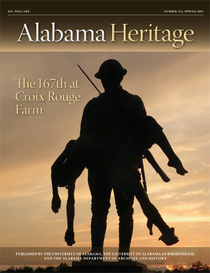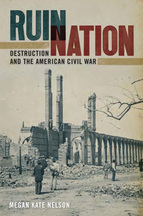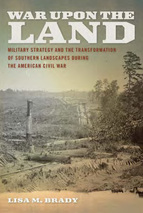|
On the cover: The Croix Rouge Farm Memorial in France. (Photo by Yannick Marques)
|
FEATURE ABSTRACTS
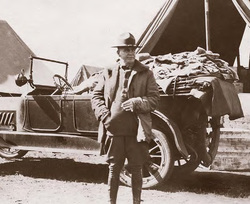 Col. William P. Screws, with his ever-present
Col. William P. Screws, with his ever-present cigar, at Montgomery’s Vandiver Park in 1917.
(Josephine Screws McGowin)
"Send Me All the Alabamians You Can Get": The 167th Infantry at Croix Rouge Farm
By Nimrod T. Frazer
During World War One, the Germans planned a major offensive designed to end the conflict definitively. However, they neglected to consider adequately the arrival of American troops, who changed the outcome of the war. Among those troops were the men of the Rainbow Division and its 167th (Alabama) Infantry. Although the Alabamians fought in different locations throughout the war, one particular battle, the Battle of Croix Rouge Farm, stands out in their history. Nimrod T. Frazer, author of Send the Alabamians: World War One Fighters in the Rainbow Division (University of Alabama Press, 2014), recounts this crucial battle and the stories of the heroic Alabamians who fought in it.
By Nimrod T. Frazer
During World War One, the Germans planned a major offensive designed to end the conflict definitively. However, they neglected to consider adequately the arrival of American troops, who changed the outcome of the war. Among those troops were the men of the Rainbow Division and its 167th (Alabama) Infantry. Although the Alabamians fought in different locations throughout the war, one particular battle, the Battle of Croix Rouge Farm, stands out in their history. Nimrod T. Frazer, author of Send the Alabamians: World War One Fighters in the Rainbow Division (University of Alabama Press, 2014), recounts this crucial battle and the stories of the heroic Alabamians who fought in it.
About the Author
Nimrod T. Frazer was born in Montgomery in an Alabama family with a strong military tradition. His great-grandfather spent two years in an Union prison during the Civil War, and his father earned a Purple Heart in France in 1918. Following in their footsteps, Frazer signed up to serve his country and was sent to Korea. Serving as a tank platoon leader, he was awarded the Silver Star, and his unit received a Presidential Citation. Frazer attended Columbia University and received an MBA from Harvard University before engaging in a successful business career. A scholar of history, Frazer contributes regularly to local papers. A published author, he focuses on military matters. His latest work, Send the Alabamians: World War One Fighters in the Rainbow Division, is being published by the University of Alabama Press in May 2014. Service to his country and his community remain Frazer’s main focus. In 2009, he was inducted into the Alabama Business Hall of Fame.
Additional Resources
For more information regarding the Battle of Croix Rouge and World War One, the author suggests the following. Click on each item to visit the web pages:
Croix Rouge Foundation website
British website on WWI
Maps and chronology of WWI
General US website on WWI
US Centennial commission
For places to visit in the US, the author recommends the following:
National World War One Museum in Kansas City
Indiana War Memorial Museum in Indianapolis
CORRECTION to print magazine: The date of the battle next to the first photo was August 26, 1918, and should have been July 26, 1918.
Nimrod T. Frazer was born in Montgomery in an Alabama family with a strong military tradition. His great-grandfather spent two years in an Union prison during the Civil War, and his father earned a Purple Heart in France in 1918. Following in their footsteps, Frazer signed up to serve his country and was sent to Korea. Serving as a tank platoon leader, he was awarded the Silver Star, and his unit received a Presidential Citation. Frazer attended Columbia University and received an MBA from Harvard University before engaging in a successful business career. A scholar of history, Frazer contributes regularly to local papers. A published author, he focuses on military matters. His latest work, Send the Alabamians: World War One Fighters in the Rainbow Division, is being published by the University of Alabama Press in May 2014. Service to his country and his community remain Frazer’s main focus. In 2009, he was inducted into the Alabama Business Hall of Fame.
Additional Resources
For more information regarding the Battle of Croix Rouge and World War One, the author suggests the following. Click on each item to visit the web pages:
Croix Rouge Foundation website
British website on WWI
Maps and chronology of WWI
General US website on WWI
US Centennial commission
For places to visit in the US, the author recommends the following:
National World War One Museum in Kansas City
Indiana War Memorial Museum in Indianapolis
CORRECTION to print magazine: The date of the battle next to the first photo was August 26, 1918, and should have been July 26, 1918.
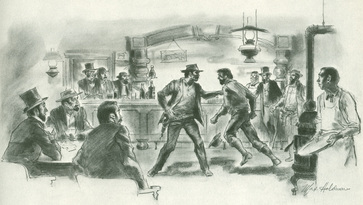 Max Heldman's images appeared on the covers of national
Max Heldman's images appeared on the covers of national magazines, and his artistic pursuits took him to New York
and Chicago, yet he always considered Birmingham both
his home and his favorite subject. (Courtesy Alan W. Heldman)
Birmingham's Max Heldman
By Mary Virginia Pounds Brown and Linda McNair Cohen
Although he was not a native of Alabama, Max Heldman arrived in Birmingham as a young child, and the city received a great deal of attention in his visual art. Heldman’s oeuvre, in fact, proceeds as a visual love letter of sorts, documenting both significant events and everyday life in the city he called home. Virginia Pounds Brown—who collaborated with Heldman to produce a collection of his work—and Linda McNair Cohen recount Heldman’s life and explore some of his most significant Birmingham images.
About the Authors
Virginia Pounds Brown is an award-winning author, bookseller, and librarian from Birmingham. She earned degrees from Randolph-Macon Woman’s College (Phi Beta Kappa) and Emory University. She served as a librarian in the Birmingham Public Library and at Birmingham-Southern College. In 1950 she opened the Book-Keepers bookstore in Mountain Brook and later started the Book-Keepers Press. She is the author, co-author, or editor of many works of importance to Alabama, including Alabama Mounds to Missiles; Alabama Heritage Illustrated; The World of the Southern Indian; Southern Indian Myths and Legends; Toting the Lead Row: Ruby Pickens Tartt, Alabama Folklorist; Winnataska Remembered; and others. She published and collaborated with Max Heldman on Max Heldman’s Birmingham.
Linda McNair Cohen is a graduate of Maryville College (Tennessee) and the University of Alabama, where she received a master’s degree in library and information studies. She worked as a bookseller for Virginia Pounds Brown in the Book-Keepers bookstore and later as a librarian at the Birmingham Public Library.
By Mary Virginia Pounds Brown and Linda McNair Cohen
Although he was not a native of Alabama, Max Heldman arrived in Birmingham as a young child, and the city received a great deal of attention in his visual art. Heldman’s oeuvre, in fact, proceeds as a visual love letter of sorts, documenting both significant events and everyday life in the city he called home. Virginia Pounds Brown—who collaborated with Heldman to produce a collection of his work—and Linda McNair Cohen recount Heldman’s life and explore some of his most significant Birmingham images.
About the Authors
Virginia Pounds Brown is an award-winning author, bookseller, and librarian from Birmingham. She earned degrees from Randolph-Macon Woman’s College (Phi Beta Kappa) and Emory University. She served as a librarian in the Birmingham Public Library and at Birmingham-Southern College. In 1950 she opened the Book-Keepers bookstore in Mountain Brook and later started the Book-Keepers Press. She is the author, co-author, or editor of many works of importance to Alabama, including Alabama Mounds to Missiles; Alabama Heritage Illustrated; The World of the Southern Indian; Southern Indian Myths and Legends; Toting the Lead Row: Ruby Pickens Tartt, Alabama Folklorist; Winnataska Remembered; and others. She published and collaborated with Max Heldman on Max Heldman’s Birmingham.
Linda McNair Cohen is a graduate of Maryville College (Tennessee) and the University of Alabama, where she received a master’s degree in library and information studies. She worked as a bookseller for Virginia Pounds Brown in the Book-Keepers bookstore and later as a librarian at the Birmingham Public Library.
Camels in Cahawba
By Linda Derry
By Linda Derry
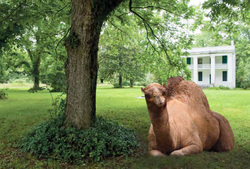 Camels ultimately proved to be ill-suited to the
Camels ultimately proved to be ill-suited to thesouthern climate. (Photo illustration courtesy
Robin McDonald)
Historic Cahawba remains most known for its archaeological riches and its role as one of Alabama’s capital cities. However, its history also reflects a curious intersection of exotic animals and the slave trade. Thanks to emerging research, this article uncovers the brief but provocative history of camels in Cahawba, noting the somewhat dubious circumstances of their import and the colorful characters that accompanied their arrival.
About the Author
Linda Derry is the site director of the Old Cahawba Archaeological Park, a historic site of the Alabama Historical Commission, in Orrville near Selma. Before coming to Alabama nearly thirty years ago, she was the lead field archaeologist for the Colonial Williamsburg Foundation in Virginia and has a master’s degree from the College of William and Mary. She currently serves on the Selma Historic Commission, the Black Belt Heritage Area Task Force, The Cahaba Foundation, and the editorial board of the Journal of Community Archaeology and Heritage. She enjoys creating new and engaging ways to share Alabama’s history, archaeology, and authentic folklore such as Cahawba’s annual Haunted History tour, and loves working with Cahawba descendants to document and share family histories through a quarterly newsletter.
About the Author
Linda Derry is the site director of the Old Cahawba Archaeological Park, a historic site of the Alabama Historical Commission, in Orrville near Selma. Before coming to Alabama nearly thirty years ago, she was the lead field archaeologist for the Colonial Williamsburg Foundation in Virginia and has a master’s degree from the College of William and Mary. She currently serves on the Selma Historic Commission, the Black Belt Heritage Area Task Force, The Cahaba Foundation, and the editorial board of the Journal of Community Archaeology and Heritage. She enjoys creating new and engaging ways to share Alabama’s history, archaeology, and authentic folklore such as Cahawba’s annual Haunted History tour, and loves working with Cahawba descendants to document and share family histories through a quarterly newsletter.
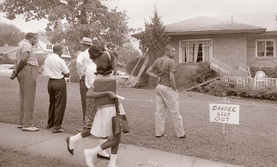 The November 20,1963, bombing of civil rights
The November 20,1963, bombing of civil rightsattorney Arthur Shores’ house, in which his wife
was injured, was the second time his house had
been bombed. (Library of Congress)
The Last Bombing: The Story of Nina Miglionico
By Samuel A. Rumore Jr.
The city of Birmingham experienced many bombs and other violent events during the civil rights movement, even earning the unsavory nickname “Bombingham” for its tumultuous state. One of the lesser-known bombings occurred at the home of city councilwoman Nina Miglionico, whose outspoken nature had garnered attention. Miglionico’s father disarmed the bomb before it exploded, but the event helped bring additional attention to the city and its pockets of violent resistance to civil rights activism.
About the Author
Samuel A. Rumore Jr. has maintained an active law practice in Birmingham, Alabama, since 1974 and practiced law with Nina Miglionico for thirty-five years. He received his undergraduate degree in history from Notre Dame University, earned a law degree from the University of Alabama School of Law, and has a master’s degree in library and information studies from the University of Alabama. He has written more than eighty-five articles on the courthouses of Alabama and other topics for the Alabama Lawyer Magazine. He also authored the article on Nina Miglionico for the online Encyclopedia of Alabama. Rumore served as president of the Alabama State Bar for the 2000–2001 term of office and is chairman of the Alabama Lawyers’ Hall of Fame selection committee. He serves on the board of the Birmingham Public Library, the Alabama Bench and Bar Historical Society, and the Birmingham History Center.
By Samuel A. Rumore Jr.
The city of Birmingham experienced many bombs and other violent events during the civil rights movement, even earning the unsavory nickname “Bombingham” for its tumultuous state. One of the lesser-known bombings occurred at the home of city councilwoman Nina Miglionico, whose outspoken nature had garnered attention. Miglionico’s father disarmed the bomb before it exploded, but the event helped bring additional attention to the city and its pockets of violent resistance to civil rights activism.
About the Author
Samuel A. Rumore Jr. has maintained an active law practice in Birmingham, Alabama, since 1974 and practiced law with Nina Miglionico for thirty-five years. He received his undergraduate degree in history from Notre Dame University, earned a law degree from the University of Alabama School of Law, and has a master’s degree in library and information studies from the University of Alabama. He has written more than eighty-five articles on the courthouses of Alabama and other topics for the Alabama Lawyer Magazine. He also authored the article on Nina Miglionico for the online Encyclopedia of Alabama. Rumore served as president of the Alabama State Bar for the 2000–2001 term of office and is chairman of the Alabama Lawyers’ Hall of Fame selection committee. He serves on the board of the Birmingham Public Library, the Alabama Bench and Bar Historical Society, and the Birmingham History Center.
DEPARTMENT ABSTRACTS
 Selma is one of twelve cities and towns
Selma is one of twelve cities and towns currently enrolled in the Main Street
Alabama program. (Robin McDonald)
Southern Architecture and Preservation
Main Street Alabama
By Mary M. Helmer
Although preservation of historic structures remains a crucial need throughout the state, often willing individuals and communities struggle to find adequate resources to protect historic properties. This quarter’s Southern Architecture & Preservation column offers information about an important organization designed to help communities consider the economic aspects of preservation. The Main Street Alabama Program offers towns throughout the state the opportunity and resources needed to help protect their heritage, ensuring the survival of significant landmarks across Alabama.
About the Author
Mary M. Helmer, president and state coordinator of Main Street Alabama, is a certified Main Street manager with fifteen years of experience. Robert Gamble, standing editor of the “Southern Architecture and Preservation” department of Alabama Heritage, is senior architectural historian for the Alabama Historical Commission.
Main Street Alabama
By Mary M. Helmer
Although preservation of historic structures remains a crucial need throughout the state, often willing individuals and communities struggle to find adequate resources to protect historic properties. This quarter’s Southern Architecture & Preservation column offers information about an important organization designed to help communities consider the economic aspects of preservation. The Main Street Alabama Program offers towns throughout the state the opportunity and resources needed to help protect their heritage, ensuring the survival of significant landmarks across Alabama.
About the Author
Mary M. Helmer, president and state coordinator of Main Street Alabama, is a certified Main Street manager with fifteen years of experience. Robert Gamble, standing editor of the “Southern Architecture and Preservation” department of Alabama Heritage, is senior architectural historian for the Alabama Historical Commission.
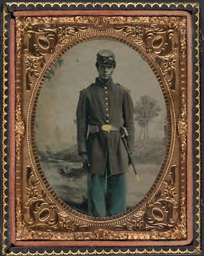 This hand-colored tintype portrays an
This hand-colored tintype portrays anunidentified African American soldier
wearing a forage cap with the insignia of
the 103rd Regiment's Company B.
(Library of Congress)
Becoming Alabama: Quarter by Quarter
By Joseph W. Pearson, Megan L. Bever, and Matthew L. Downs
Editor’s Note—Alabama Heritage, the Summersell Center for Study of the South, the University of Alabama Department of History, and the Alabama Tourism Department offer this department as a part of the statewide “Becoming Alabama” initiative—a cooperative venture of state organizations to commemorate Alabama’s experiences related to the Creek War, the Civil War, and the civil rights movement. Quarter by quarter we will take you to the corresponding seasons 200, 150, and 50 years ago—sometimes describing pivotal events, sometimes describing daily life, but always illuminating a world in flux. We will wait for the ultimate outcomes as our forebears did—over time. For those joining the story in progress, you can find earlier quarters on our website at www.alabamaheritage.com/BecomingAlabama.
This quarter’s installment of Becoming Alabama opens with the Battle of Horseshoe Bend, in which Andrew Jackson secured victory over the Red Stick Creeks. Then it turns to the Civil War era, exploring the role of African American troops fighting for the Union and illuminating the tensions surrounding their presence. Finally, it considers the fight for school desegregation throughout the southeast, noting how the court cases decided in Prince Edward County, Virginia, affected desegregation efforts in Alabama.
About the Authors
Joseph W. Pearson is a PhD student in the department of history at the University of Alabama. His research interests include the nineteenth-century South, antebellum politics, and political culture. Megan L. Bever is currently a doctoral student in the department of history at the University of Alabama. Her research interests include the nineteenth-century South and the Civil War in American culture. Matthew L. Downs (PhD, Alabama) is an assistant professor of history at the University of Mobile. His dissertation focused on the federal government’s role in the economic development of the Tennessee Valley.
By Joseph W. Pearson, Megan L. Bever, and Matthew L. Downs
Editor’s Note—Alabama Heritage, the Summersell Center for Study of the South, the University of Alabama Department of History, and the Alabama Tourism Department offer this department as a part of the statewide “Becoming Alabama” initiative—a cooperative venture of state organizations to commemorate Alabama’s experiences related to the Creek War, the Civil War, and the civil rights movement. Quarter by quarter we will take you to the corresponding seasons 200, 150, and 50 years ago—sometimes describing pivotal events, sometimes describing daily life, but always illuminating a world in flux. We will wait for the ultimate outcomes as our forebears did—over time. For those joining the story in progress, you can find earlier quarters on our website at www.alabamaheritage.com/BecomingAlabama.
This quarter’s installment of Becoming Alabama opens with the Battle of Horseshoe Bend, in which Andrew Jackson secured victory over the Red Stick Creeks. Then it turns to the Civil War era, exploring the role of African American troops fighting for the Union and illuminating the tensions surrounding their presence. Finally, it considers the fight for school desegregation throughout the southeast, noting how the court cases decided in Prince Edward County, Virginia, affected desegregation efforts in Alabama.
About the Authors
Joseph W. Pearson is a PhD student in the department of history at the University of Alabama. His research interests include the nineteenth-century South, antebellum politics, and political culture. Megan L. Bever is currently a doctoral student in the department of history at the University of Alabama. Her research interests include the nineteenth-century South and the Civil War in American culture. Matthew L. Downs (PhD, Alabama) is an assistant professor of history at the University of Mobile. His dissertation focused on the federal government’s role in the economic development of the Tennessee Valley.
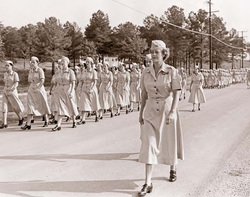 Women train for active duty at Fort McClellan
Women train for active duty at Fort McClellanin 1955. (Alabama Dept. of Archives & History)
Alabama Women
"The WAC is a Soldier Too": Alabama and the Women's Army Corps
By Stephanie Chaifoux
During the 1940s efforts to establish a female wing of the American Army led to the creation of the Women’s Army Corps (WAC), a group dedicated to the same ideals as the Army and founded on the same principles of discipline and patriotism. In conjunction with this, a WAC post was formed at Fort McClellan, near Anniston, Alabama, allowing WACs housing, training, and a space in which to pursue their profession surrounded by other women similarly serving their country. Stephanie Chalifoux researches the history of the WACs and the Fort McClellan post, offering an insightful look at an often-overlooked community.
About the Author
Stephanie Chalifoux graduated with her PhD in history from the University of Alabama in 2013 and is currently an adjunct instructor for the history department. Joshua D. Rothman, standing editor of the “Alabama Women” department of Alabama Heritage, is professor of history at the University of Alabama and director of the university’s Frances S. Summersell Center for the Study of the South, which sponsors this department.
"The WAC is a Soldier Too": Alabama and the Women's Army Corps
By Stephanie Chaifoux
During the 1940s efforts to establish a female wing of the American Army led to the creation of the Women’s Army Corps (WAC), a group dedicated to the same ideals as the Army and founded on the same principles of discipline and patriotism. In conjunction with this, a WAC post was formed at Fort McClellan, near Anniston, Alabama, allowing WACs housing, training, and a space in which to pursue their profession surrounded by other women similarly serving their country. Stephanie Chalifoux researches the history of the WACs and the Fort McClellan post, offering an insightful look at an often-overlooked community.
About the Author
Stephanie Chalifoux graduated with her PhD in history from the University of Alabama in 2013 and is currently an adjunct instructor for the history department. Joshua D. Rothman, standing editor of the “Alabama Women” department of Alabama Heritage, is professor of history at the University of Alabama and director of the university’s Frances S. Summersell Center for the Study of the South, which sponsors this department.
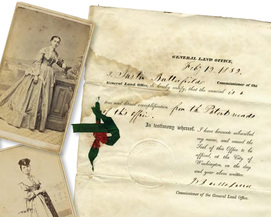 Shown are (above) Bettie Wynne Webster
Shown are (above) Bettie Wynne Websterand Emma Chapman Wynne and (right) an
1852 document from the US General Land
Office. (W.S. Hoole Special Collections
Library, University of Alabama)
Revealing Hidden Collections
Genealogical Resources Available at the University of Alabama
By Mary Bess Kirksey Paluzzi
Thanks to a recent proliferation of interest in ancestry and origins, many lesser-known holdings of universities and libraries are being recognized for their genealogical content. In this installment of “Revealing Hidden Collections,” Mary Bess Paluzzi, Associate Dean for Special Collections, alerts readers to the wide range of resources offered by libraries at the University of Alabama. Readers interested in researching their own family history will welcome the various tools available through library systems.
About the Author
Mary Bess Kirksey Paluzzi has an M.L.S. degree from the University of Alabama (UA). Before coming to the UA as the University Libraries’ Associate Dean for Special Collections, she served as coordinator for the Birmingham Public Library’s Linn Henley Research Library and as executive director of the Aliceville POW Museum. Louis A. Pitschmann, standing editor of the “Revealing Hidden Collections” department of Alabama Heritage, is dean of the University Libraries at the University of Alabama and director of the Alabama Center for the Book, which co-sponsor this department.
Genealogical Resources Available at the University of Alabama
By Mary Bess Kirksey Paluzzi
Thanks to a recent proliferation of interest in ancestry and origins, many lesser-known holdings of universities and libraries are being recognized for their genealogical content. In this installment of “Revealing Hidden Collections,” Mary Bess Paluzzi, Associate Dean for Special Collections, alerts readers to the wide range of resources offered by libraries at the University of Alabama. Readers interested in researching their own family history will welcome the various tools available through library systems.
About the Author
Mary Bess Kirksey Paluzzi has an M.L.S. degree from the University of Alabama (UA). Before coming to the UA as the University Libraries’ Associate Dean for Special Collections, she served as coordinator for the Birmingham Public Library’s Linn Henley Research Library and as executive director of the Aliceville POW Museum. Louis A. Pitschmann, standing editor of the “Revealing Hidden Collections” department of Alabama Heritage, is dean of the University Libraries at the University of Alabama and director of the Alabama Center for the Book, which co-sponsor this department.
 Tung blossom season was described
Tung blossom season was described as "Pink Clouds in Dixie." (Whitney
Adrienne Snow)
Portraits & Landscapes
Tung Trees in Alabama
By Whitney Adrienne Snow
Although no longer prevalent thanks to hurricanes and other weather events, tung trees once constituted a significant portion of Alabama’s agricultural landscape. Prized for the valuable oil derived from their seeds, tung trees were originally imported from China and flourished most notably in Alabama under the attention of C.R. Baldwin and his wife, Gae. After C.R.’s death, Gae continued raising the crops, pursuing her husband’s legacy, and making quite a name for herself in the growing, but ultimately short-lived, industry.
About the Author
Whitney Adrienne Snow wrote her dissertation on the domestic tung oil industry and is now an assistant professor of history at Midwestern State University.
Tung Trees in Alabama
By Whitney Adrienne Snow
Although no longer prevalent thanks to hurricanes and other weather events, tung trees once constituted a significant portion of Alabama’s agricultural landscape. Prized for the valuable oil derived from their seeds, tung trees were originally imported from China and flourished most notably in Alabama under the attention of C.R. Baldwin and his wife, Gae. After C.R.’s death, Gae continued raising the crops, pursuing her husband’s legacy, and making quite a name for herself in the growing, but ultimately short-lived, industry.
About the Author
Whitney Adrienne Snow wrote her dissertation on the domestic tung oil industry and is now an assistant professor of history at Midwestern State University.
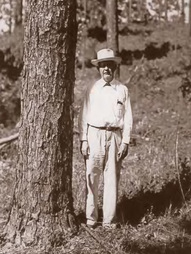 Isaac Richard Anderson, known as
Isaac Richard Anderson, known as "Mr. Rich" to most, owned Ralph
Lumber Company. He was known
as a hard worker and a good judge
of character. (John Davidson)
Recollections
Hillwood: Life in a Sawmill Camp
By Cassandra Mahaffey Nelson
Based on John Davidson's Memoirs
Between 1931 and 1947, the small community of Hillwood, Alabama, a town linked to the Ralph Lumber Company and its sawmill, developed to support the members of the sawmill population. Although the effects of the Great Depression pervaded, residents felt a deep sense of community and connection, remembering a pleasant way of life.
About the Author
Cassandra Mahaffey Nelson is currently pursuing her master's in English literature from the University of Alabama. Her interests include eighteenth-century British prose and southern gothic literature.
Hillwood: Life in a Sawmill Camp
By Cassandra Mahaffey Nelson
Based on John Davidson's Memoirs
Between 1931 and 1947, the small community of Hillwood, Alabama, a town linked to the Ralph Lumber Company and its sawmill, developed to support the members of the sawmill population. Although the effects of the Great Depression pervaded, residents felt a deep sense of community and connection, remembering a pleasant way of life.
About the Author
Cassandra Mahaffey Nelson is currently pursuing her master's in English literature from the University of Alabama. Her interests include eighteenth-century British prose and southern gothic literature.
Reading the Southern Past
The Scourge of War
by Stephen Goldfarb
This quarter’s book review column considers two new approaches to the Civil War: Ruin Nation: Destruction and the American Civil War by Megan Kate Nelson and War Upon the Land: Military Strategy and the Transformation of Southern Landscape during the American Civil War by Lisa M. Brady (both published in 2012 by the University Press of Georgia). Nelson’s book focuses on various kinds of “ruination” enacted by the war, while Brady evaluates the environmental cost of the conflict.
About the Author
Stephen Goldfarb holds a PhD in the history of science and technology. He retired from a public library in 2003.
The Scourge of War
by Stephen Goldfarb
This quarter’s book review column considers two new approaches to the Civil War: Ruin Nation: Destruction and the American Civil War by Megan Kate Nelson and War Upon the Land: Military Strategy and the Transformation of Southern Landscape during the American Civil War by Lisa M. Brady (both published in 2012 by the University Press of Georgia). Nelson’s book focuses on various kinds of “ruination” enacted by the war, while Brady evaluates the environmental cost of the conflict.
About the Author
Stephen Goldfarb holds a PhD in the history of science and technology. He retired from a public library in 2003.
